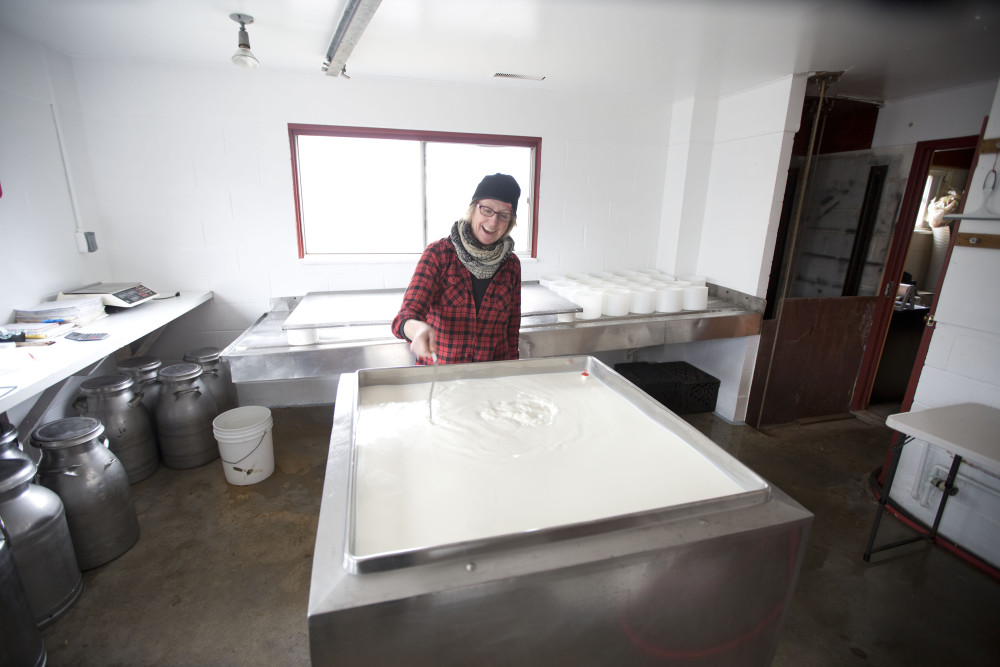By Michaelle Bond
The Philadelphia Inquirer.
CHESTER SPRINGS, Pa.
Sue Miller loves hanging out in her cheese cave.
“Sometimes I get attached to certain wheels of cheese,” said Miller, co-owner of Birchrun Hills Farm, a dairy farm about 30 miles outside Philadelphia. “And my husband says, ‘You know, it’s meant to be sold.'”
She knows.
Her love of cheese grew out of necessity. About nine years ago, declining milk prices and rising costs had Miller and her husband, Ken, worried they might lose the small farm they hoped one day to pass on to their two sons.
Like other small dairy operators across the country, the first-generation farmers decided they needed to innovate to survive.
So Sue Miller, 49, turned to community support and the craft of artisanal cheeses, which she makes in a small rental facility and sells around the region. Thanks to an online campaign that collected donations from customers, farmers and supporters, the couple now plan to build their own cheese cave.
The Millers are like many small farmers who must increasingly rely on strong community relationships and high-quality products, rather than trying to increase production, which can be costly or impossible in areas with vanishing farmland, said Brian Snyder, president of the Pennsylvania State Council of Farm Organizations.
“Sue represents this whole new approach to the economics of farming,” said Snyder, who is also executive director of the Pennsylvania Association for Sustainable Agriculture, of which Miller is a board member.
The number of dairy farmers turning to specialty cheese-making has been growing for more than 25 years, alongside the swell of gluten-free and organic products, said Michael Tunick, a research chemist at the U.S. Department of Agriculture.
“If you learn how to make cheese, you can take that milk and turn it into something very valuable,” he said.
The Millers sell milk from their 80 Holstein cows to Wawa and Land O’Lakes. But it was the Millers’ six raw milk cheeses, sold at Philadelphia restaurants, local farmers’ markets, breweries, Whole Foods, and in Pittsburgh and Vermont, that helped save their farm.
Pennsylvania ranks seventh nationwide among cheese producers, with more than 415 million pounds of cheese made last year, according to the U.S. Department of Agriculture.
A number of other farms near the Millers have expanded their operations to offer cheeses.
Sue Miller entered three of hers in the Pennsylvania Farm Show’s inaugural cheese competition in January, “Birchrun Blue” blue cheese, “Red Cat” mild washed-rind cheese, and “Tomme Mole” creamy cheese aged in a rub of olive oil, coffee, cocoa, cayenne pepper, and cinnamon.
Each won a blue ribbon.
But do not ask Miller to name her favorite cheese.
“That’s like asking someone who their favorite child is,” she said.
With a new cheese cave, Miller said, she will be able to produce new types.
She and her husband took out a loan for a few hundred thousand dollars to pay for the construction of their cheese cave, so called as a nod to the original way of aging cheese.
But they also needed at least $25,000 to buy equipment and to create the cave-like conditions cheeses need: low temperatures and high humidity.
They started raising money last year with $5,000 in donations from a Cheese Ball gala conceived by Tenaya Darlington, a St. Joseph’s University associate English professor who writes a blog about cheese under the name Madame Fromage.
They also launched an online Kickstarter campaign that drew 235 donations from friends, customers and other cheese makers in 31 days.
To boost donations online, the Millers offered donors the chance to name calves as they are born. On the list of baby names are Gertrude Holstein, Juniper Moo, Daffodil, and Mikey Geno, in honor of a Philadelphia artist who specializes in paintings of cheese and other foods.
Miller said she had experienced overwhelming support from her customers and the cheese community.
“It’s easy to forget that people support you and want you to survive,” she said. “I feel like this was about lifting up our family and our farm to the next level.”














































































































































































































































































































































































